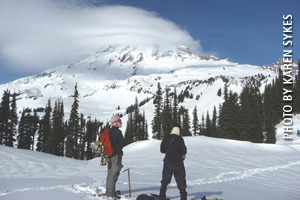Western Snow Sports: Northwest winter forecast

Is La Niña on her way back?
By Michael Fagin
Ready for the slopes and wondering what kind of snow year it’s going to be? Some of the early forecast models are suggesting a La Niña pattern setting up. However, several others are suggesting neutral conditions.
If La Niña occurs, this would keep skiers happy because it tends to bring above average mountain snowfall. However, if there is an Enso Neutral (La Nada) phase it would tend to bring normal snowfall conditions to the Northwest. Conversely, the bad boy El Niño brings below average snowfall.
So, what do we make of this and how do we know whether to get excited or depressed about the upcoming season?
Confused? You’re not alone
Confused about the difference between El Niño and La Niña? Even La Nada? You’re not alone.
The winter patterns and associated snowfall for the Washington and Oregon Cascades and the major Idaho mountain ranges can at times be highly correlated to the El Niño and La Niña phases. But what exactly are El Niño and La Niña?
The Spanish translation for El Niño is “the boy” and La Niña “the girl.” Nada can mean nothing or anything. The word La Nada is a term coined by a climatologist from NASA to describe what is neither an El Niño nor a La Niña phase. The scientific name for La Nada is ENSO (El Niño/Southern Oscillation) Neutral.
ENSO Phases
One of the main ingredients in preparing a winter forecast is determining what phase of the ENSO (El Niño/Southern Oscillation) we are in. ENSO describes what the sea surface temperatures are in the eastern Pacific Ocean off the coast of Peru—if you can believe that!
El Niño is declared when there are above normal sea surface temperatures in this region and La Niña when there are below normal sea surface temperatures. Neutral (or La Nada) is forecast when temperatures are close to normal.
If we are in an El Niño phase the sea surface temperatures would be in the range of 0.9 degrees Fahrenheit or 7.2 F above normal. For La Nina, the range would be from 0.9 F to 7.2 F below normal.
These lower or higher temperatures would need to occur for several straight months for there to be an El Niño or La Niña phase. Finally, the higher the deviation from normal, the stronger is the El Niño or La Niña phase.
La Niña
Skiers usually rejoice when we are in a La Niña phase during the winter. Why? We usually have the jet stream and the associated storm track that is aimed at the Pacific Northwest. This means that the Washington and Oregon Cascades and the Idaho mountains receive above normal snowfall.
During the winter of 2010–2011 for example, we were in a La Niña phase which varied from weak to moderate.
This recap shows just how much more snow was on the ground compared to normal on May 1, 2011:
Mt. Baker, 175 percent
Stevens Pass, 140 percent
Paradise at Mount Rainer, 155 percent
Mt. Hood, 138 percent
The Bitterroot and Sawtooth Ranges in Idaho experienced similar numbers.
El Niño
If skiers in the Northwest rejoice during a La Niña event, then they’ll probably need a good dose of anti-depressants during an El Niño winter. The typical El Niño phase has the Northwest well below normal precipitation and above normal temperatures.
An El Niño winter is characterized by the jet stream and associated storm track aimed at California (usually Southern California). During many El Niño phases the Northwest will have a strong ridge of high pressure that will remain in place for much of the winter.
The good news for hikers is an early start to the hiking season. The bad news for everyone is that this can cause drought during the summer because much of the Northwest receives its water supply from snowmelt, which might be gone by early summer.
Pacific Decadal Oscillation (PDO)
PDO refers to the sea surface temperatures from the coast of Alaska south to the Washington, Oregon and California coasts. Currently we are in a cool phase PDO (below normal sea surface temperatures) which can intensify the aforementioned La Niña event. Some meteorologists have suggested that the abundant snowfall in the Pacific Northwest during the winter of 2010–2011 was due to the cool PDO phase.
More oscillations? Why not. While the ENSO phases of El Niño and La Niña last for usually less than a year, the PDO can become established for a 20-year period.
The World of other Oscillations
I have always said one good oscillation deserves another. There is the Arctic Oscillation (AO), Madden Julian Oscillation (MJO), and many more. The bottom line is that the seasonal forecasts are extremely complicated because of the interplay of factors like these oscillations.
So even if we are in a strong La Niña phase in which we’d normally expect heavy mountain snowfall, it is possible that snowfall might actually be below normal because of this interplay. After all, the study of meteorology and associated fluid dynamics has been described as part of the “Chaos Theory.”
2011–2012
Can we make a non-chaotic forecast for the winter of 2011-2012? One of the best sites to monitor is the Climate Prediction Center Web site: www.cpc.ncep.noaa.gov/products/precip/CWlink/MJO/enso.shtml#discussion.
As mentioned earlier, forecasters are indicating a La Niña Phase for this upcoming winter — keeping Northwest skiers happy, of course. But stay tuned. This is the fickle Northwest, after all.
Michael Fagin is the weather forecaster for Washington Online Weather (WOW) and appears periodically on KUOW for weather and hiking segments. Check out his weather outlooks at http://faginweatherworld.blogspot.com/



